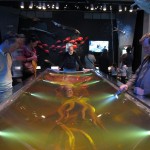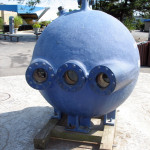![]() Beware when you go on tropical holiday. Species richness of bacteria is higher in those waters. For many organisms on land (birds, mammals, snails, plants, insects, and more) diversity increases as one progresses toward the equator. For many marine groups, snails for example, the same patterns applies. This is referred to often as the LSDG or the latitudinal species diversity gradient.
Beware when you go on tropical holiday. Species richness of bacteria is higher in those waters. For many organisms on land (birds, mammals, snails, plants, insects, and more) diversity increases as one progresses toward the equator. For many marine groups, snails for example, the same patterns applies. This is referred to often as the LSDG or the latitudinal species diversity gradient.
What drives this pattern? The hypotheses are numerous but typically the two favorites are primary productivity and temperature. On one hand a bigger pie allows for more slices. On the other hand temperature speeds up reactions scaling up to ecological interactions and evolutionary processes that may promote higher diversity. A recent study lead by Fuhrman documents the LSDG for the first time in marine microbes. Diversity was higher in tropical waters in the Pacific and Atlantic. One might have predicted that the LSDG would be absent in bacteria with extremely high abundances and great dispersal abilities that would swamp genetic intertia for speciation.
Perhaps more interesting is that the patterns for bacteria are driven by temperature not productivity. Bacteria was equally rich in low and high productivity waters but equally warm. Cold waters despite productivity level were equally low.
Admittedly I am torn. The last author of the study is my former post doctoral advisor. A study demonstrating that temperature does not drive LSDG’s in some other groups, deep-sea mollusks and cructaceans, was published by my Ph.D. advisor. He did this by simply and elegantly showing that LSDG’s exist in the deep sea where temperature varies just a few degrees C (the deep is equally cold and dark despite location).
What to do? What to do? These studies together probably indicate that LSDG’s are likely driven by factors that are taxon specific.
Fuhrman, J.A., Steele, J.A., Hewson, I., Schwalbach, M.S., Brown, M.V., Green, J.L., Brown, J.H. (2008). A latitudinal diversity gradient in planktonic marine bacteria. Proceedings of the National Academy of Sciences DOI: 10.1073/pnas.0803070105
Rex, M.A., Stuart, C.T., Hessler, R.R., Allen, J.A., Sanders, H.L., Wilson, G.D. (1993). Global-scale latitudinal patterns of species diversity in the deep-sea benthos. Nature, 365(6447), 636-639. DOI: 10.1038/365636a0






So the long-winded question we should be asking ourself’s is “what is it that increases as you get nearer the equator and influences factors contributing towards evolution, but is not temperature or productivity of environment?”.
How about UV radiation?
How about temperature and and productivity? UV is unlikely to be a factor to organisms leaving on the deep-sea floor
I think its the Coriolis Force man. Since the earth is spinning so fast it concentrates things in the center, which is near the equator. Its like when you swirl water with floaties in it. All the floaties concentrate in the middle. We’re like those floaties! It totally makes sense